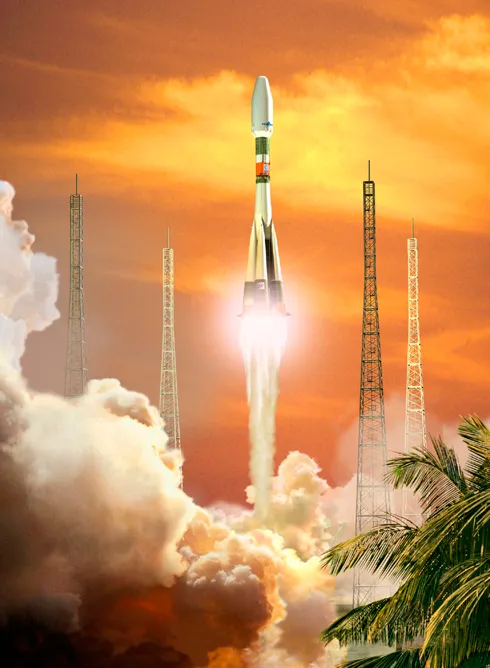
Artist's impression of a Soyuz liftoff from ESA's Spaceport in French Guiana. Credit: ESA/D Ducros
For more than 50 years, it has blasted off to space from the deserts of central Asia or the frozen forests of northern Russia, but the Soyuz launcher is soon to be launching from a more tropical site.
Europe’s Spaceport in French Guiana now has a Soyuz site ready for its first launch.
Construction of the Soyuz site began in February 2007, with Russian staff arriving in the south American country in mid-2008 to assemble the launch table, mobile gantry, fuelling systems and test benches.
The first two Soyuz launchers arrived from Russia by sea in November 2009, to be assembled in the new preparation and integration building.

The Soyuz launch vehicle that will be used at Europe’s Spaceport is the Soyuz-2 version called Soyuz-ST (pictured left) – the most recent version of the family of Russian launchers that began the Space Race more than 50 years ago by launching Sputnik and Yuri Gagarin into space.
In the last week of March, the site was declared ready for its first rocket, after inspections of all the mechanical, fluid and electrical elements, such as the pad’s umbilical arms, as well as all the buildings, including the launch control centre.
The launch site is almost identical to the other Soyuz sites, Baikonur in Kazakhstan and Plesetsk in Russia, although it has adapted to European safety regulations.
The most visible difference is a 45m-tall mobile gantry (pictured below), which provides a protected environment as payloads are installed on the vertical launcher. The gantry has internal, movable work platforms for access to the rocket at various levels.
As at the other launch sites, the Soyuz launchers will continue to be assembled horizontally before being transported to the launch site by railway.
Later this year, launch teams will run through a simulated launch to make sure that the vehicle’s transfer to the launch zone, its erection into the vertical position, its installation on the pad, and the testing of ground and launcher interfaces work perfectly.
These final tests will give the green light for the first Soyuz flight from French Guiana in the third quarter of 2011.

